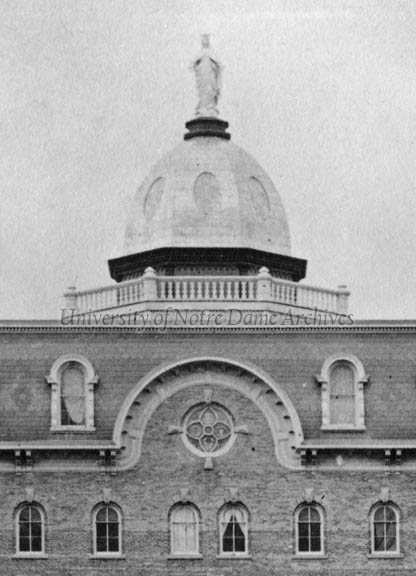
On the Feast of Corpus Christi, May 31, 1866, the University of Notre Dame was officially consecrated and the statue of the Virgin Mary atop the dome was dedicated. The newspapers at the time claimed that “the ceremony will eclipse everything of the kind which has ever taken place in the United States” [New York Herald, 05/20/1866, page 5].

The cornerstone of the first Main Building was laid in August of 1843. Twenty years later, Notre Dame had out-grown the building and University President Rev. Patrick Dillon set about expanding it, following the vision for rapid growth that Rev. Edward Sorin initiated. Construction on the expansion started in 1865 and it would be occupied by that fall, although the edifice wouldn’t be fully complete until the fall of 1866.
The dome of Second Main Building was made of wood and covered in tin. Anthony Buscher of Chicago carved the wooden statue, which was twelve feet tall, weighed 1800 pounds, and cost $850. The dome and statue were painted white, representing the purity of the Virgin Mary. In the octagonal oratory at the base of the dome was a $1500 solid gold crown made in France and blessed by Pope Pius IX. Etched into the crown were the names of the donors and the mysteries of the Rosary.

Ever the marketeer, Rev. Edward Sorin invited “every bishop in the country and every important cleric and congressman in the Midwest” to the dedication ceremonies [Schlereth, page 5]. Twelve bishops and archbishops made the trip to Notre Dame, including Revs. Martin Spalding of Baltimore, John Luers of Fort Wayne, Louis Amadeus Rappe of Cleveland, John Timon of Buffalo, John Henni of Milwaukee, and Thomas Grace of St. Paul. Over five thousand people visited campus for the event, more than could be accommodated for Mass or the grand banquet.
[photoshelter-img i_id=”I0000kZ_Noxi8J4c” buy=”1″ caption=”Engraving of campus, including the first Sacred Heart Church and Second Main Building, c1866.” width=”570″ height=”305″]
Part of the day’s festivities included prizes of $100 in gold for the best prose and poetic essays regarding the Virgin Mary. The writing were judged solely on merit, with the judges not knowing the names of the authors. Orestes Brownson and Louis Constantine (an assumed pen-name) took top prize for their prose. Professor George B. Males of St. Mary’s College, Maryland, and Mrs. Anna H. Dorsey of Washington, D.C., won for their poetic essays. The day ended with Vespers and a Eucharistic procession around St. Joseph’s Lake with all the pomp and circumstance that typified such celebrations at Notre Dame.
The growing nationwide enthusiasm and support for Notre Dame seen on this day in 1866 would help to sustain the University through one of its greatest setbacks – the fire of April 23, 1879, which would destroy this and many other buildings on campus.
Sources:
PNDP 10-AD-04
PNDP 1866
GFCL 48/15-16
GNDL 6/16
A Dome of Learning: The University of Notre Dame’s Main Building
by Thomas J. Schlereth, 1991

Even though I am not alumni, I really enjoy reading about my favorite college
Even though I am not alumni, I so much enjoy reading about the history of this awesome school